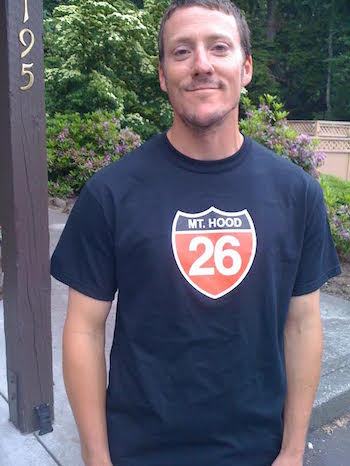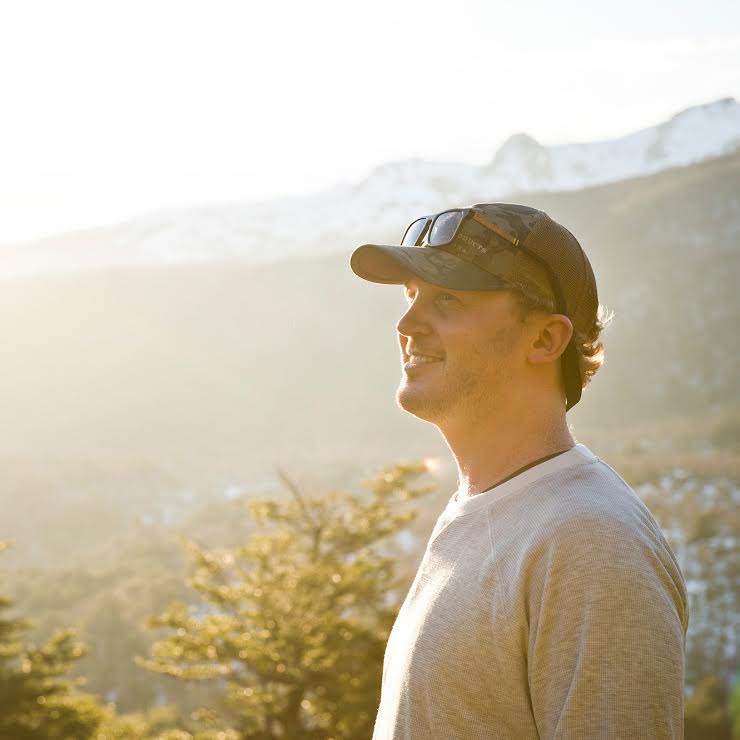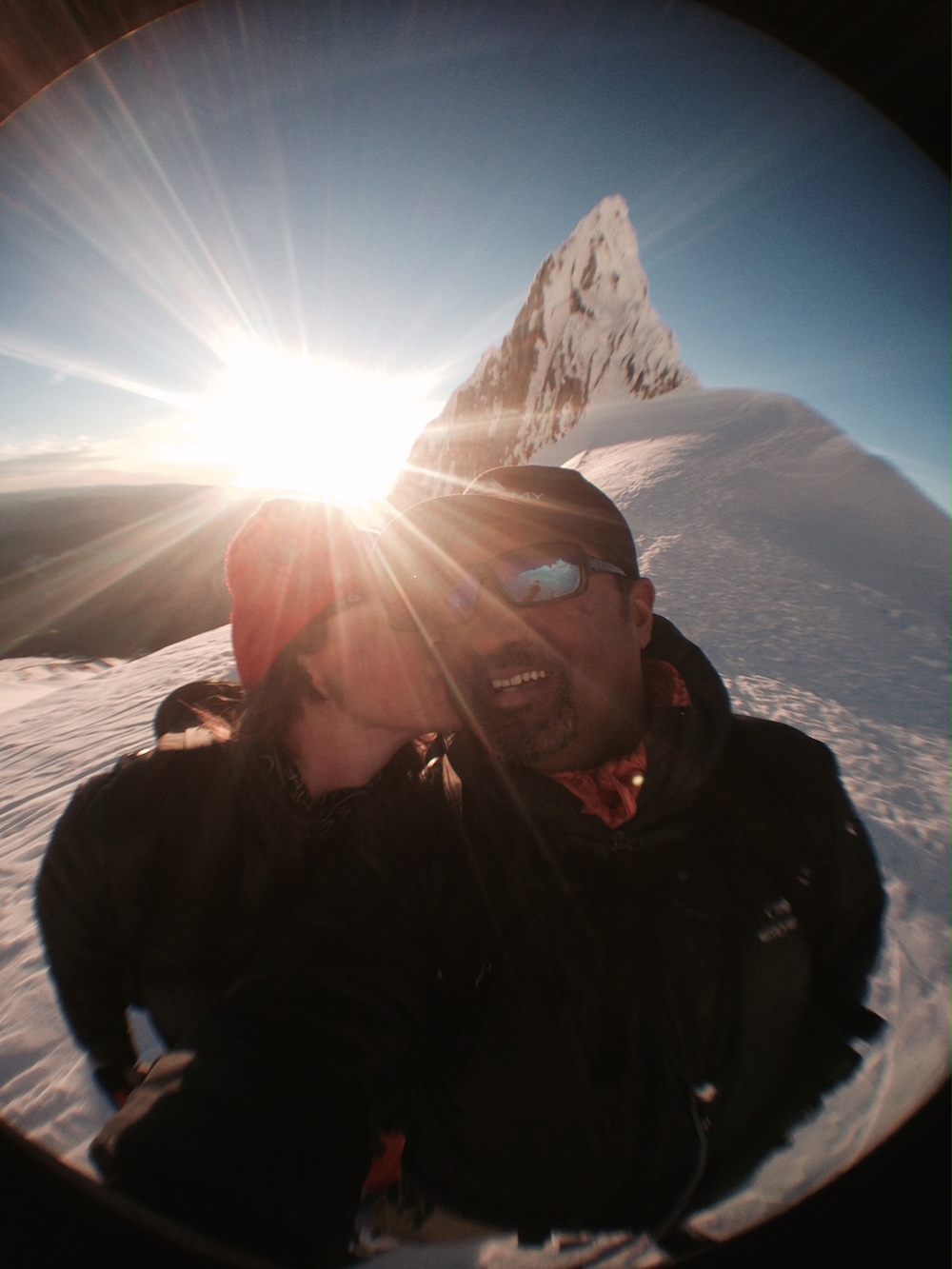Editor’s Note: We’re busting this story out from the archives for two reasons: 1, it’s a good read that shouldn’t be buried. And 2, it is a story that says a lot about modern skiing and the Mt. Hood’ community’s do-it-yourself spirit of innovation.
Griffin Cummings wasn’t thinking about reinventing skiing the day he decided to snap the tails off his skis on Mount Hood. He was just sick and tired of smacking his head into the hard snow.
Cummings and his ski buddies Josh Frazier and Ben Bliesner had been shredding slush at Timberline all day, using death cookies left behind by the grooming crew to leap up and spin 180 degrees and land backwards. “Because our tails weren’t tipped up, I augured my skis into the snow on one landing and whip-lashed super-bad,” Cummings recalls. “It was painful, and I was angry. I needed to break my skis and make some tips on the tails.”
So he went over to Bliesner’s Jeep in the parking lot, wedged his Blizzards into the space between the brush guard and the bumper, gauged where he wanted the rear tips to be, and broke his skis. Bliesner, who always had a knack for building things, later bent some aluminum into place at the Sandy High School metal shop to hold the tail tips up. They stuck in some T-bolts, and voila. Twin-tips.
The altered skis were crude, but they worked. They were stiff, tough, 195-centimeter all-mountain skis that were kicked up in the back for landing, launching and skiing backwards. Cummings rode them for years. Frazier and Bliesner built their own versions, and the three teenagers started doing things on skis that they wouldn’t have been able to do without their trusty twin-tips.
That was in the summer of 1992 on Mount Hood. Twenty-two-and-a-half years later, twin-tip skis are everywhere. There are as many skiers as snowboarders in the half-pipes and terrain parks. Freestyle skiers rip it as fast as 80 miles an hour in reverse, land switch off enormous jumps, and pull off ridiculously complex tricks off rails, walls, boxes, stumps, and just about anything else that can be jibbed. It is amazing how far the sport has progressed in a couple of decades.
Trace the twin-tip skiing movement back to its roots, and along with the first Line ski-boards and the first Salomon 1080s, you will find three teenagers on Mount Hood who looked up to snowboarders and loved inline skating, who built their own twin-tip skis and rode them for years without poles, drawing more ridicule than respect, until finally things changed, big-time, and the biggest names in skiing took notice, and the industry changed.
“We knew that what we had going on was the future of skiing,” says Frazier. “And absolutely nobody believed us. We were 15 years old.”
It came from snowboarding and rollerblading — that’s right, rollerblading
Griffin Cummings, pictured to the left, grew up in Washington State, shredding Snoqualmie Pass at the resort then known as PacWest, an early snowboarding Mecca. “PacWest was the center of snowboarding in the Northwest,” he recalls. “When I was growing up, that’s where all the dope snowboarders came to shred: Todd Schlosser, Jamie Lynn, Temple Cummins, Matt Cummins. Those are legends. I wanted to be as cool as them.”
Cummings and his family moved to Welches on Mount Hood when he was a freshman in high school, and one of the big reasons for the move was to get the kids on the mountain as often as possible. Griffin’s twin brother Mitchell was a snowboarder and his older brothers Gavin and Ryan were big-time skiers who had a lot of respect for snowboarders.
Griffin met Bliesner and Frazier at Sandy High, and the three of them hit it off immediately, with their shared interests in skiing, skateboarding, snowboarding and the then-super-cool sport of inline skating. They would roll around in Bliesner’s Jeep with a bunch of home-made rails and ramps and hit the skate parks from Hood to Portland and back. Cummings got good enough to earn his first sponsorship and entertain plans of becoming a pro inline skater – an attainable dream in the early 90s.
“We would go down to town and skate at Burnside and try not to get beat up,” remembers Bliesner. “We’d look for rails and just fly all over the place. It was safety in numbers with the three of us.”
“I don’t know how we got away with some of the stuff we did,” adds Frazier. “I look at the gaps that we skated, and it’s just crazy. I was pointing one out the other day. We used to skate across the road right there, stop traffic and gap off that sidewalk into that parking lot. There’s two huge trees there that I remember them planting to kind of disrupt us. I’m looking at it nowadays coming home from the chiropractor and I’m like, No wonder I need a chiropractor.”
‘Hey, why can’t we land backwards?’
A lot of skiers were complaining about knuckle-dragger snowboarders in those days, as snowboarding took off and skiing lost ground. Cummings, Bliesner and Frazier saw it differently. They formed a small posse of Mount Hood skiers who were committed to learning from snowboarders and shredding with them.
It didn’t always go well. They got chased out of half-pipes by pissed-off boarders and ridiculed by ski racers for going without poles. But they knew they were onto something.
One day they were skiing Multorpor with a big group of snowboarders, trading lines and exchanging tricks, and things just clicked. “it just kind of caught on,” Frazier recalls. “And the big thing for us was, ‘Hey, why can’t we land backwards?'”
Landing backwards was a key skill for their inline skating, but on snow it was a different beast. “It just makes a lot of sense to come up to a box and slide and come off of it backwards,” says Bliesner. “Trying to do it skiing, well, that isn’t going to work.”
Not unless you bend your tips up, that is. Not long after Cummings snapped his Blizzards in the Timberline parking lot, Frazier retrofitted his K2s to make twin-tips, and Bliesner started experimenting with various prototypes.
“We would take skis into the shop and try every way we could to break them and glue them, to try to add a layer of metal and glue it in there,” he says. “Finally what worked best was just taking some sheet metal and bending it up, and then cutting the ski down to the base and just folding it up and screwing it down using T-bolts. We would laminate a piece of metal on the end that would hold the tip in place.”
For Cummings, sawing his skis became just another tuning task. “You just take the ski and make three marks with a radial saw, and you bring it right about down to the edge, just a little bit above it,” he says. “The three cuts allow the ski to bend in three spots. And then Ben would get me some aluminum and he would do a good bend and T-bolt it in. Solid. Never gonna break.”
‘Who’s gonna take a 15-year-old kid seriously?’
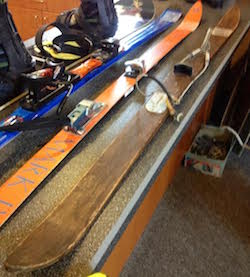 Twin-tips had been built and skied before. The big old wooden twin-tips pictured to the left (photo courtesy of Zeb Yaklich) helped photographers to ski backwards while taking pictures.
Twin-tips had been built and skied before. The big old wooden twin-tips pictured to the left (photo courtesy of Zeb Yaklich) helped photographers to ski backwards while taking pictures.
The Olin Mark IV featured turned-up rear tips for freestyle tricks in the 70s, along with the Rossignol Smash and the Hart Freestyle. But like ski ballet, those freestyle models didn’t really last.
Modern twin-tip skis, on the other hand, are almost certainly here to stay, along with the many independent ski companies from Armada to ON3P that have emerged over 15-plus years of improved designs.
Frazier says he recognized burly twin-tips were something special the first time he skied his retrofitted K2 Extremes. “The way the ski performed, the way it turned, especially in Northwest snow, it was a game-changer. But we were 15. Who’s going to take a 15-year-old kid seriously?
“Even my dad laughed at me. He was highly supportive, but still to this day he thinks it’s crazy. He’s a skier, he skied for years. He even monoskied. So he was into those cool new concepts. He just didn’t believe it. He didn’t think it was possible to ski backwards.”
Frazier and his friends set out to prove that it was not only possible to ski backwards, it was a blast. They refined their twin-tip designs and experimented with taking off and landing switch, honing a no-poles, wide-stance Mount Hood Style with more in common with snowboarding than mogul skiing, ripping the wind features on Marmot Ridge like BMX bikers and catching huge air.
Even with their background in inline skating, they rejected snow-blades and ski-boards in favor of hardy, full-length, all-mountain skis that could handle any terrain.
Cummings got a sponsorship with K2, and the first pair of skis they sent him, he bent up the tips. Same thing with the Nordicas he got a few years later.
Other skiers mocked them. The fact that they dared to ski without poles was particularly offensive to some skiers. It got them barred from major competitions and instigated at least one tequila-fueled fist fight.
The industry ignored them. One of the first trips Frazier made after getting his driver’s license was up to Vashon Island in Washington to knock on doors at K2 headquarters. No luck there, or with Salomon.
They decided to go it alone. While still in high school, Bliesner came up with a prototype for what they called the Solution Twin-Tip, an extension to attach to the tail of the ski to enable backwards skiing. Nobody knew twin-tip extensions existed at that point, but within a few years Bliesner would be custom-building Solution Twin-Tips for the one and only Shane McConkey.
‘When we caught the attention of Moseley and McConkey, that’s when we really knew we had something.’
Back in the 90s, Mt. Hood Meadows used to host some lively freestyle competitions with slopestyle, big air, halfpipe and skier and snowboard cross races. Cummings and his friends got to compete against some of the all-time greats, athletes like Pep Fujas and Candide Thovex.
For these competitions, they served as a sort of “local circus show” in Frazier’s words, the whacky guys who take off and land backwards. Their tricks caught the attention of folks from the Camp of Champions, and they ended up getting invited to the first camp up at Whistler with freestyle skiers.
It was a huge opportunity. They drove up to Canada in the summer of 1998 with their Mt. Hood style and improvised boards determined to make the most of it.
“There we were with our slapped-together twin-tips,” says Bliesner. “We’re doing tricks that no one has really seen before. And across the glacier is the Canadian Air Force and they’ve got Salomon 1080 prototypes, and it was like ‘What in the world is this? This is such bullshit!’”
Leading the New Canadian Air Force, of course, was the late, great JP Auclair, the pioneering twin-tip freeskier, along with his coach Mike Douglas, the “Godfather of Freeskiing.” Auclair, Douglas and their partners were testing out the new 1080s that they had helped Salomon develop, the industry’s first full-length twin-tip design. Auclair would later break off to develop twin-tips for the ground-breaking company he co-founded, Armada.
The Canadian stars arrived at the glacier a few weeks after Frazier, Cummings and Bliesner did, and they totally upstaged the Solution Twin-Tip. Their Salomon twin-tip skis made big news in the skiing world. The Hood Rats from Oregon didn’t get anywhere near as much attention. But they did get a phone call from arguably the best skier alive at the time, Shane McConkey. McConkey had heard about their Solution Twin Tips, and he wanted a custom-built pair to fit his skis for some big upcoming competitions.
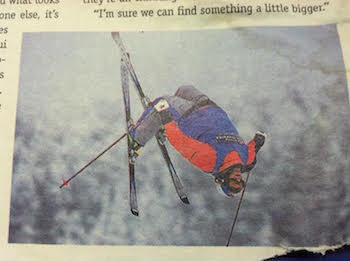 To this day, Bliesner still keeps a copy of Powder Magazine showing McConkey pulling one of his patented backflips while with his custom-built Solution Twin-Tips.
To this day, Bliesner still keeps a copy of Powder Magazine showing McConkey pulling one of his patented backflips while with his custom-built Solution Twin-Tips.
McConkey’s great rival Jonny Moseley also wanted a pair, and he got furious when he couldn’t get his in time for an upcoming competition.
“When we caught the attention of Moseley and McConkey, that’s when we really knew we had something,” says Frazier. “And that was when the industry was like, ‘Yeah, We’ll take that.’”
Before long, all the major ski manufacturers were cranking out full-length twin-tip boards. The early models were too flimsy for Cummings’s liking, but they got better over time. Much better. By 2008 the New York Times was reporting that twin-tip skis were by far the fastest-growing style of skis: “Twin-tips are new, cool and make people feel young. So middle-age men and women are buying them, and not just for their sons and daughters.”
‘Right there is the proof. The kids are destroying it.’
Bliesner injured his knee in 1999 and had to back off from hard-core freeskiing, but he still gets his share of turns in on Mount Hood as a climber, ski mountaineer, coach and father of three. His Solution Twin Tip designs never really led to a legit business, but they planted the seed for his current companies, Rhododendron Technology and Cascade Alpine. His latest invention for Cascade Alpine is a lightweight climbing tool for building ice caves and performing other mountain tasks called the “shovit,” U.S. patent #8002322.
Cummings was recently named a freeskiing coach with the new Head to Hood program launching this season at Timberline. He coached for 14 years at Camp of Champions in Canada and nine years at Windells in Oregon. He fractured his pelvis a few years ago but that hasn’t stopped him from learning new tricks every season.
Not so long ago, Cummings considered it a big deal to see two pairs of twin-tips on one lift. Today four pairs on one lift is more of a rule than an exception.
“In the beginning when we were starting the twin tips, the ski companies couldn’t see any value in it,” he says. “And now it has saved every one of their companies. Saved the industry.”
Like Cummings and Bliesner, Frazier still lives in Welches, where he works as a stone mason and contractor when he isn’t out teaching his four-year-old son how to ski on Hood. He still gets out solo for backcountry turns and the occasional big air.
Looking back, Frazier says it amazes him how quickly his sport progressed, as young Oregon skiers from Eric Pollard to Sammy Carlson to Hudson Knoll have embraced the Mt. Hood twin-tip style and built onto it.
“That first couple of years, Griffin and Ben and I were the only ones who stuck up for our stuff. And then a few years later, you’re riding a chairlift and you see some kid just ripping it in twin tips. I remember seeing Hudson Knoll when he was like 6. I remember Sammy Carlson when he was 6. I remember Eric Pollard. I had to work for years figuring out this halfpipe run at Meadows that was my competition dream run. And I turn around and see this kid drop in and he’s like 12. And he destroyed it. It was Pollard. And he did my exact line. He ripped it and I was like, ‘Whoah! Now I’m done!’”
“It was awesome, though. That was the beauty of it. It was our baby. And it works, and right there is the proof. Those kids are destroying it.”
Last modified: December 10, 2014

